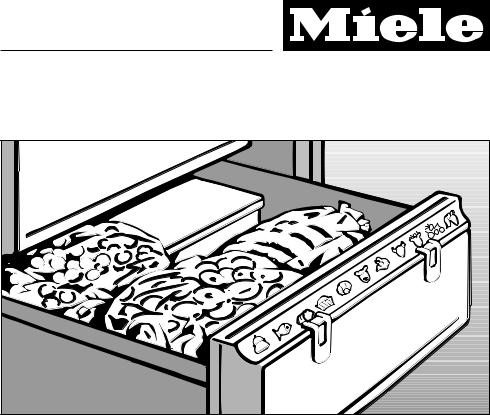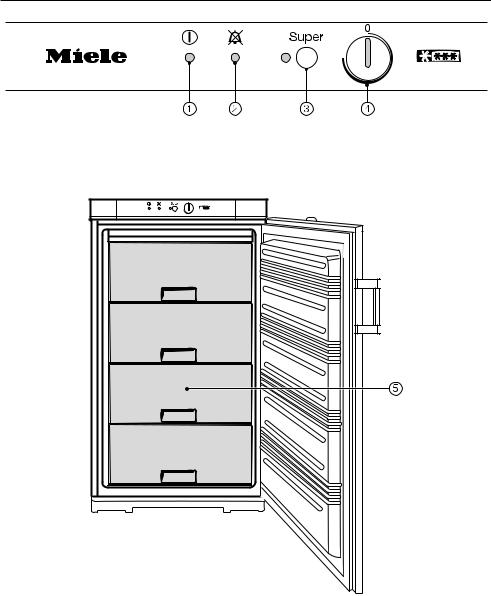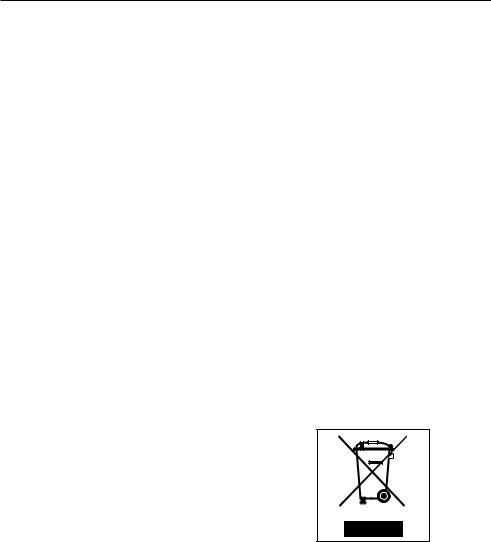Miele F 1313 S User Manual

Operating and installation instructions
Freezer |
F 1313 S |
To avoid the risk of accidents or damage to the appliance, it is
essential to read these operating instructions before it is installed or used for the
first time.
G
M.-Nr. 06 154 980

Contents
Description of the appliance. . . . . . . . . . . . . . . . . . . . . . . . . . . . . . . . . . . . . . . . . 4 Optional accessories . . . . . . . . . . . . . . . . . . . . . . . . . . . . . . . . . . . . . . . . . . . . . . . . 5 Thermometer . . . . . . . . . . . . . . . . . . . . . . . . . . . . . . . . . . . . . . . . . . . . . . . . . . . 5
Caring for the environment . . . . . . . . . . . . . . . . . . . . . . . . . . . . . . . . . . . . . . . . . . 6
Warning and Safety instructions . . . . . . . . . . . . . . . . . . . . . . . . . . . . . . . . . . . . . 7
How to save energy . . . . . . . . . . . . . . . . . . . . . . . . . . . . . . . . . . . . . . . . . . . . . . . 11
Switching on and off . . . . . . . . . . . . . . . . . . . . . . . . . . . . . . . . . . . . . . . . . . . . . . 12 Switching off for longer periods of time . . . . . . . . . . . . . . . . . . . . . . . . . . . . . . . . . 12
The correct temperature . . . . . . . . . . . . . . . . . . . . . . . . . . . . . . . . . . . . . . . . . . . 13 Temperature selection . . . . . . . . . . . . . . . . . . . . . . . . . . . . . . . . . . . . . . . . . . . . . . 13
Temperature alarm. . . . . . . . . . . . . . . . . . . . . . . . . . . . . . . . . . . . . . . . . . . . . . . . 14 Switching on the alarm system . . . . . . . . . . . . . . . . . . . . . . . . . . . . . . . . . . . . . . . 14
Super freeze . . . . . . . . . . . . . . . . . . . . . . . . . . . . . . . . . . . . . . . . . . . . . . . . . . . . . 15 Freezing fresh food . . . . . . . . . . . . . . . . . . . . . . . . . . . . . . . . . . . . . . . . . . . . . . . . 15 Super freeze. . . . . . . . . . . . . . . . . . . . . . . . . . . . . . . . . . . . . . . . . . . . . . . . . . . . . . 15
Freezing and storing food. . . . . . . . . . . . . . . . . . . . . . . . . . . . . . . . . . . . . . . . . . 17 Maximum freezing capacity. . . . . . . . . . . . . . . . . . . . . . . . . . . . . . . . . . . . . . . . . . 17 Storing frozen food. . . . . . . . . . . . . . . . . . . . . . . . . . . . . . . . . . . . . . . . . . . . . . . . . 17 Home freezing . . . . . . . . . . . . . . . . . . . . . . . . . . . . . . . . . . . . . . . . . . . . . . . . . . . . 17 Hints on home freezing. . . . . . . . . . . . . . . . . . . . . . . . . . . . . . . . . . . . . . . . . . . 17 Packing . . . . . . . . . . . . . . . . . . . . . . . . . . . . . . . . . . . . . . . . . . . . . . . . . . . . . . . 18 Before placing food in the freezer . . . . . . . . . . . . . . . . . . . . . . . . . . . . . . . . . . 18 Placing food in the freezer . . . . . . . . . . . . . . . . . . . . . . . . . . . . . . . . . . . . . . . . 18 Defrosting. . . . . . . . . . . . . . . . . . . . . . . . . . . . . . . . . . . . . . . . . . . . . . . . . . . . . . . . 19 Cooling drinks . . . . . . . . . . . . . . . . . . . . . . . . . . . . . . . . . . . . . . . . . . . . . . . . . . . . 19
Defrosting . . . . . . . . . . . . . . . . . . . . . . . . . . . . . . . . . . . . . . . . . . . . . . . . . . . . . . . 20
Cleaning . . . . . . . . . . . . . . . . . . . . . . . . . . . . . . . . . . . . . . . . . . . . . . . . . . . . . . . . 22 Cleaning the outer casing, the interior and accessories . . . . . . . . . . . . . . . . . . . . 22 Ventilation gaps . . . . . . . . . . . . . . . . . . . . . . . . . . . . . . . . . . . . . . . . . . . . . . . . . . . 22 Door seal . . . . . . . . . . . . . . . . . . . . . . . . . . . . . . . . . . . . . . . . . . . . . . . . . . . . . . . . 22 Metal grille at the back of the appliance . . . . . . . . . . . . . . . . . . . . . . . . . . . . . . . . 23
Problem solving guide . . .. . . . . . . . . . . . . . . . . . . . . . . . . . . . . . . . . . . . . . . . . . 24
Noises . . . . . . . . . . . . . . . . . . . . . . . . . . . . . . . . . . . . . . . . . . . . . . . . . . . . . . . . . 26
Service Department . . . . . . . . . . . . . . . . . . . . . . . . . . . . . . . . . . . . . . . . . . . . . . . 27
Electrical connection. . . . . . . . . . . . . . . . . . . . . . . . . . . . . . . . . . . . . . . . . . . . . . 28

Contents
Electrical connection U.K. . . . . . . . . . . . . . . . . . . . . . . . . . . . . . . . . . . . . . . . . . . . 28
Installation . . . . . . . . . . . . . . . . . . . . . . . . . . . . . . . . . . . . . . . . . . . . . . . . . . . . . . 29 Location . . . . . . . . . . . . . . . . . . . . . . . . . . . . . . . . . . . . . . . . . . . . . . . . . . . . . . . . . 29 Climate range . . . . . . . . . . . . . . . . . . . . . . . . . . . . . . . . . . . . . . . . . . . . . . . . . . 29 Ventilation. . . . . . . . . . . . . . . . . . . . . . . . . . . . . . . . . . . . . . . . . . . . . . . . . . . . . . . . 29 Installation . . . . . . . . . . . . . . . . . . . . . . . . . . . . . . . . . . . . . . . . . . . . . . . . . . . . . . . 29 Aligning the appliance. . . . . . . . . . . . . . . . . . . . . . . . . . . . . . . . . . . . . . . . . . . . . . 29
Changing the door hinging . . . . . . . . . . . . . . . . . . . . . . . . . . . . . . . . . . . . . . . . . 30

Description of the appliance
aIn-operation indicator light bAlarm indicator light
eFreezer drawers
cSuper freeze button and indicator light
dOn/Off and temperature selector dial
4

Description of the appliance
Optional accessories
Thermometer
The thermometer can be used for checking the temperature inside the freezer.
It is available from the Miele Spare
Parts Department or from your dealer.
5

Caring for the environment
Disposal of the packing material
The transport and protective packing has been selected from materials which are environmentally friendly for disposal, and can normally be recycled.
Ensure that any plastic wrappings, bags etc. are disposed of safely and kept out of the reach of babies and young children. Danger of suffocation!
Rather than just throwing these materials away, please ensure that they are recycled.
Disposal of your old appliance
Please ensure that the appliance presents no danger to children while being stored for disposal.
It should be unplugged or disconnected from the mains electricity supply by a competent person. The plug must be rendered useless and the cable cut off directly behind the appliance to prevent misuse. See the "Warning and Safety" section of this booklet for further details.
Electrical and electronic appliances often contain materials which, if handled or disposed of incorrectly, could be potentially hazardous to human health and to the environment. They are, however, essential for the correct functioning of your appliance.
Please dispose of your old appliance at your local community waste collection / recycling centre and not with your household waste.
Take care not to damage the pipework at the back of it before or during transportation to an authorised collection depot.
In this way, refrigerant in the pipework and oil in the compressor will be contained, and will not leak out into the environment.
6

Warning and Safety instructions
This appliance complies with all relevant legal safety requirements. Improper use can, however, present a risk of both personal injury and material damage.
To avoid the risk of accidents and damage to the appliance, read the operating instructions carefully before installation and before using for the first time. They contain important notes on the installation, safety, operation and care of the appliance.
Keep these operating instructions in a safe place and pass them on to any future user.
Correct use
This appliance is intended for domestic use only, to store deep
frozen food, freeze fresh food, and to make ice.
Any other usage is not supported by the manufacturer and could be dangerous. The manufacturer cannot be held liable for damage caused by incorrect or improper use of the appliance.
This appliance is not a toy! To avoid the risk of injury, do not allow children to play on or near it, or to play with the controls. Supervise its use by the elderly or infirm.
Technical safety
This appliance contains the coolant Isobutane (R600a), a natural gas
which is environmentally friendly. Although it is flammable, it does not damage the ozone layer and does not increase the greenhouse effect. The use of this coolant has, however, led to a slight increase in the noise level of the appliance. In addition to the noise of the compressor, you might be able to hear the coolant flowing around the system. This is unavoidable, but does not have any adverse effect on the performance of the appliance.
Care must be taken during the transportation and installation of the appliance that no parts of the cooling system are damaged. Leaking coolant can damage the eyes.
In the event of any damage:
-avoid open fires and anything which creates a spark,
-disconnect from the mains,
-air the room in which the appliance is located for several minutes and
-contact the Service Department for advice.
The more coolant there is in an appliance, the larger the room it should be installed in. In the event of a leakage, if the appliance is in a small
room, there is the danger of combustible gases building up.
For every 8 g of coolant at least 1 m3 of room space is required. The amount of coolant in the appliance is stated on the data plate inside the appliance.
7

Warning and Safety instructions
Before connecting the appliance to the mains supply, make sure that
the rating on the data plate corresponds to the voltage and frequency of the household supply. This data must correspond in order to avoid the risk of damage to the appliance. Consult a qualified electrician if in any doubt.
The electrical safety of this appliance can only be guaranteed
when continuity is complete between the appliance and an effective earthing system, which complies with local and national safety regulations. It is most important that this basic safety requirement is present and regularly tested. Where there is any doubt, the household wiring system should be inspected by a qualified electrician. The manufacturer cannot be held liable for the consequences of an inadequate earthing system (e.g. electric shock).
Safe operation of the appliance is only assured if it has been installed
and connected in accordance with these operating and installation instructions.
This equipment may only be used in mobile installations such as
ships, caravans, aircraft etc. if a risk assessment of the installation has been carried out by a suitably qualified engineer.
Installation work, maintenance and repairs may only be carried out by
suitably qualified and competent persons in accordance with national and local safety regulations.
Repairs and other work by unqualified persons could be dangerous and the manufacturer will not be held liable.
Ensure current is not supplied to the appliance while maintenance or repair work is being carried out.
The appliance is only completely isolated from the electricity supply
when:
–it has been switched off at the socket and the plug has been withdrawn.
–the mains fuse is withdrawn, or
–the screw-out fuse is removed (in countries where this is applicable).
Do not connect the appliance to the mains electricity supply by an
extension lead.
Extension leads do not guarantee the required safety of the appliance (e.g. danger of overheating).
8

Warning and Safety instructions
Use
Never handle frozen food with wet hands. Your hands may freeze to
the frozen food. Danger of frost burn.
Do not take ice cubes out with your bare hands and never place ice
cubes or ice lollies in your mouth straight from the freezer.
The very low temperature of the frozen ice or lollies can cause frost burn to the lips and tongue.
Do not allow children to play with the appliance, for example to climb
inside the drawers or to swing on the door.
Do not refreeze thawed or partially thawed food.
Defrosted food should be used up as quickly as possible, as food soon loses it nutritional value and goes off. Defrosted food may only be re-frozen after it has been cooked.
Storage times will depend on several factors, including the freshness and quality of the food as well as the temperature at which it is
stored. To avoid the risk of food poisoning, follow the instructions given on the food manufacturer's packaging on the storage conditions required, as well as the "use by" date.
Do not store explosive materials in the appliance or any products
containing propellants (e.g. spray cans). Thermostats switching on may produce sparks which could present a fire hazard. Flammable compounds could explode.
Do not store cans or bottles containing carbonated drinks or
liquids which could freeze in the freezer. The cans or bottles could explode.
Danger of injury and damage to the appliance.
When cooling drinks quickly in the freezer, make sure bottles are not left in for more than one hour, otherwise
they could burst. This could result in injury or damage.
Do not use sharp edged objects to
–remove frost and ice,
–separate frozen foods or remove ice trays. They will damage the evaporator, causing irreversible damage to the appliance.
Do not use any oils or grease on the door seals, as these will cause
the seals to deteriorate and become porous with time.
Do not block the ventilation gaps in the appliance as this would impair the efficiency of the appliance, increase
the electricity consumption and could cause damage to the appliance.
9

Warning and Safety instructions
The appliance is designed for use within certain climate ranges
(ambient temperatures), and should not be used outside this range. The climate range for your appliance is stated on the data plate inside the appliance. Installing it in a room with too low an ambient temperature, e.g. a garage, will lead to the appliance switching off for longer periods so that it cannot maintain the required temperature.
Never place electric heaters or candles in the appliance to defrost
it. These can damage the plastic parts.
Do not use defrosting sprays or de-icers, as they might contain substances which could damage the plastic parts or which could cause a
build-up of gases and pose a danger to health.
Never use a steam-cleaning appliance to defrost or clean this
appliance. Pressurised steam could reach the electrical components and cause a short circuit.
In countries where there are areas which may be subject to infestation
by cockroaches or other vermin, pay particular attention to keeping the appliance and its surroundings in a clean condition at all times. Any damage which may be caused by cockroaches or other vermin will not be covered by the guarantee.
Disposal of your old appliance
Before disposing of an old appliance, first make the door latch
or lock unusable. This way you will prevent children from accidentally locking themselves in and endangering their lives.
Disconnect it from the mains. Cut off the cable and render any plug
unusable.
Be careful not to damage any part of the pipework whilst awaiting
disposal, e.g. by
–puncturing the refrigerant channels in the evaporator.
–bending any pipework.
–scratching the surface coating.
Splashes of refrigerant can damage the eyes.
The manufacturer cannot be held liable for damage caused by non-compliance with these Warning and Safety instructions.
10
